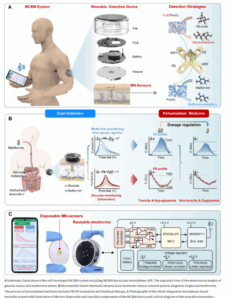In this week’s issue of The Savvy Diabetic:
-
- Dexcom CEO Steps Down
- Meta’s Wristband Uses Digital Devices Without Touch
- Microneedle-based Integrates Pharma & Biomarkers for Personalized Medicine
- Mayo Clinic Best Endocrinology
- Plant-Based Proteins for PWDs
- Fast Walking for 15 min/day Reduces Early Death Risk
- CVS Omnicare to Pay $949 million in Government Fraud Case
Dexcom CEO Kevin Sayer to step down by Elise Reuter for MedTechDive.com, 31 July 2025.
 Dexcom CEO Kevin Sayer will step down after leading the diabetes tech company for a decade. Current Chief Operating Officer Jake Leach will become CEO on Jan. 1, 2026, and join the firm’s board of directors, according to a Wednesday announcement. Sayer will help with the transition and remain executive chairman of Dexcom’s board of directors.
Dexcom CEO Kevin Sayer will step down after leading the diabetes tech company for a decade. Current Chief Operating Officer Jake Leach will become CEO on Jan. 1, 2026, and join the firm’s board of directors, according to a Wednesday announcement. Sayer will help with the transition and remain executive chairman of Dexcom’s board of directors.
Sayer said that the decision was the result of the board’s succession planning and confidence that Leach is the right leader to continue the company’s growth. “There is nobody that I trust more than Jake to lead the company into the future,” Sayer shared.
Read more: Dexcom CEO Kevin Sayer to step down
Meta’s wristband breakthrough lets you use digital devices without touching them by Paul Arnold for TechXplore.com, 25 july 2025.
 Researchers at Meta’s Reality Labs division have unveiled an experimental wristband that translates hand gestures and subtle finger movements into commands that interact with a computer. This allows a user to navigate a screen or open an app without needing a mouse, touchscreen, or keyboard. The technology can even transcribe handwriting in the air into text (currently at a speed of 20.9 words per minute).
Researchers at Meta’s Reality Labs division have unveiled an experimental wristband that translates hand gestures and subtle finger movements into commands that interact with a computer. This allows a user to navigate a screen or open an app without needing a mouse, touchscreen, or keyboard. The technology can even transcribe handwriting in the air into text (currently at a speed of 20.9 words per minute).
In a paper published in Nature, the team describes how its sEMG-RD (surface electromyography research) works. The wristband utilizes a technique called electromyography to detect electrical signals when the brain instructs the hand to perform an action. It then converts those signals into commands that control a connected device, such as your phone.
Meta’s scientists are building on decades-old ideas, but they have taken them one step further. They used artificial intelligence to analyze large amounts of data from thousands of individuals who tested the prototype, identifying common patterns. So when a user now slips on a wristband, it can look for these patterns. Therefore, unlike previous gesture-detection systems that required training on specific individuals, Meta’s wristband quickly assesses signals and adapts to the wearer.
“To our knowledge, this is the first high-bandwidth neuromotor interface with performant out-of-the-box generalization across people,” wrote the researchers.
Read more: Meta’s wristband breakthrough lets you use digital devices without touching them
Microneedle-based integrated pharmacokinetic and pharmacodynamic evaluation platform for personalized medicine by Jian Yang, Xia Gong, et al for Nature.com, 7 July 2025.
 Precision and personalized medicine for disease management necessitates real-time, continuous monitoring of biomarkers and therapeutic drugs to adjust treatment regimens based on individual patient responses.
Precision and personalized medicine for disease management necessitates real-time, continuous monitoring of biomarkers and therapeutic drugs to adjust treatment regimens based on individual patient responses.
This study introduces a wearable Microneedle-based Continuous Biomarker/Drug Monitoring (MCBM) system, designed for the simultaneous in vivo evaluation of pharmacokinetics and pharmacodynamics in diabetes. Utilizing a dual-sensor microneedle and a layer-by-layer nanoenzyme immobilization strategy, the MCBM system achieves high sensitivity and specificity in measuring glucose and metformin concentrations in skin interstitial fluid (ISF). Seamless integration with a smartphone application enables real-time data analysis and feedback, fostering a pharmacologically informed approach to diabetes management.
Read more:
Mayo Clinic earns No. 1 ranking for best US hospital for diabetes and endocrinology by Richard Smith for Healio.com/endocrinology, 29 July 2025.
 U.S. News & World Report has again named the Mayo Clinic in Rochester, Minnesota, as its No. 1 hospital in the U.S. for diabetes and endocrinology in its 2025-26 Best Hospitals rankings. The hospitals featured in this year’s top five for diabetes and endocrinology are identical to the 2024-2025 rankings. Mayo Clinic was named the No. 1 hospital for diabetes and endocrinology for the 29th consecutive year. The top five U.S. hospitals for diabetes and endocrinology according to the 2025-2026 Best Hospitals rankings are:
U.S. News & World Report has again named the Mayo Clinic in Rochester, Minnesota, as its No. 1 hospital in the U.S. for diabetes and endocrinology in its 2025-26 Best Hospitals rankings. The hospitals featured in this year’s top five for diabetes and endocrinology are identical to the 2024-2025 rankings. Mayo Clinic was named the No. 1 hospital for diabetes and endocrinology for the 29th consecutive year. The top five U.S. hospitals for diabetes and endocrinology according to the 2025-2026 Best Hospitals rankings are:
- Mayo Clinic in Rochester, Minnesota
- NewYork-Presbyterian Hospital-Columbia and Cornell
- Brigham and Women’s Hospital in Boston
- NYU Langone Hospitals in New York
- UCLA Medical Center in Los Angeles
Read more: Mayo Clinic earns No. 1 ranking for best US hospital for diabetes and endocrinology
4 Plant-Based Proteins for People With Diabetes by Madeline Kennedy for diaTribe.org, 28 July 2025.
 Plant-based proteins, such as tofu and tempeh, help regulate blood sugar levels and support weight loss, making them a healthy food option for individuals with diabetes. “Plant-based proteins are generally lower in saturated fat and calories than animal proteins,” said Bonnie Taub-Dix, a registered dietitian nutritionist.
Plant-based proteins, such as tofu and tempeh, help regulate blood sugar levels and support weight loss, making them a healthy food option for individuals with diabetes. “Plant-based proteins are generally lower in saturated fat and calories than animal proteins,” said Bonnie Taub-Dix, a registered dietitian nutritionist.
-
-
-
- Tempeh is made from fermented soybeans. It’s low in carbohydrates and high in protein, meaning that it’s unlikely to cause blood sugar spikes and will leave you feeling full. Importantly, tempeh is a whole protein. This means that, like meat, it contains all nine essential amino acids your body needs. Tempeh provides many key minerals found in red meat, including calcium, iron, and magnesium. It’s also a good source of fiber and low in saturated fat and calories.
- Legumes, such as pinto beans and soybeans, are rich in protein and contain compounds called saponins, which can be beneficial for glucose management. Studies show that having a meal with saponins reduces the risk of blood sugar spikes after eating. Beans and other legumes like chickpeas and lentils support heart health and weight loss as they’re high in fiber and low in saturated fat. Beans also provide valuable nutrients, including potassium, magnesium, and iron. Because they aren’t a whole protein (meaning they do not contain all nine essential amino acids), it’s best to combine beans and legumes with whole grains like brown rice to get optimal benefits.
- Seitan is made from gluten, the primary protein found in wheat, and is a popular vegetarian option; however, it is not ideal for individuals on a gluten-free diet. “Seitan is a good source of protein and is low in saturated fat. However, it’s not a complete protein, so it works best when you combine it with other protein sources like whole grains that can provide the other necessary amino acids,” said Taub-Dix.
- Tofu is another healthy plant-based option for people with diabetes because it’s a complete protein, meaning it contains all essential amino acids. It’s also low in saturated fat and a good source of fiber, iron, and calcium. “If you opt for extra-firm tofu, you’ll get an even higher dose of calcium,” Taub-Dix added.
-
-
Read more: 4 Plant-Based Proteins for People With Diabetes
This simple walking hack could make you live longer by Tom Howarth for ScienceFocus.com, 28 July 2025.
 Fast walking for just 15 minutes a day could significantly reduce the risk of early death – especially for low-income and Black individuals – according to a major new study published in the American Journal of Preventive Medicine. Drawing on data from nearly 80,000 participants, researchers found that brisk walking was associated with a 20 percent reduction in all-cause mortality. The effect was particularly strong for cardiovascular-related deaths and was independent of other forms of physical activity, highlighting the unique benefit of a brisk pace.
Fast walking for just 15 minutes a day could significantly reduce the risk of early death – especially for low-income and Black individuals – according to a major new study published in the American Journal of Preventive Medicine. Drawing on data from nearly 80,000 participants, researchers found that brisk walking was associated with a 20 percent reduction in all-cause mortality. The effect was particularly strong for cardiovascular-related deaths and was independent of other forms of physical activity, highlighting the unique benefit of a brisk pace.
“Our research has shown that fast walking as little as 15 minutes a day was associated with a nearly 20 per cent reduction in total mortality,” said lead investigator Dr Wei Zheng of Vanderbilt University Medical Center. By contrast, slow walking for over three hours a day was only linked to a modest 4 percent reduction, suggesting that intensity matters more than duration.
Read more: This simple walking hack could make you live longer
CVS Omnicare ordered to pay $949 million in government fraud case by Rebecca Pifer for HealthCareDive.com, 9 July 2025.
 A former Omnicare pharmacist filed the lawsuit in 2015, accusing the PBM of improperly billing Medicare, Medicaid, and the military’s Tricare program for over $135 million in drugs that weren’t actually covered by the programs.
A former Omnicare pharmacist filed the lawsuit in 2015, accusing the PBM of improperly billing Medicare, Medicaid, and the military’s Tricare program for over $135 million in drugs that weren’t actually covered by the programs.
Omnicare — the largest long-term care pharmacy services provider in the U.S. — fraudulently dispensed drugs to elderly and disabled people in long-term care and assisted living facilities without valid prescriptions, according to the complaint. The Department of Justice joined the suit in 2019, and a jury ruled in favor of the government last spring.
“Admittedly, [the fine] is a very big number. But this was a massive fraud on the Government, one that lasted over almost a decade, and one that Omnicare was aware of but avoided taking steps to correct,” the judge wrote. CVS plans to appeal the judgment.
Read more: CVS Omnicare ordered to pay $949 million in government fraud case


I think that is big news about Dexcon. It likely coincides with the slow uptick of G7? What do you think?
LOL on CVS, abut time lonesome pursued them. I know they do not care abut their employee and patients. A pox on their louses.
I can only walk that fast, if I am chasing Sheryl LOL